| CHAPTER VIII
KITES AND GLIDERS Aeroplanes | ||
8. CHAPTER VIII
KITES AND GLIDERS
KITES are of very ancient origin, and in China, Japan, and the Malayan Peninsula, they have been used for many years as toys, and for the purposes of exhibiting forms of men, animals, and particularly dragons, in their periodical displays.
THE DRAGON KITE.—The most noted of all are the dragon kites, many of them over a hundred feet in length, are adapted to sail along majestically, their sinuous or snake-like motions lending an idea of reality to their gorgeously-colored appearance in flight.
ITS CONSTRUCTION.—It is very curiously wrought, and as it must be extremely light, bamboo and rattan are almost wholly used, together with rice paper, in its construction.
Fig. 33 shows one form of the arrangement, in which the bamboo rib, A, in which only two sections are shown, as B, B, form the backbone, and these sections are secured together with pivot pins C. Each section has attached thereto a hoop, or circularly-formed rib, D, the rib passing through the section B, and these ribs are connected
These circular ribs, D, are designed to carry a
plurality of light paper disks, F, which are attached
at intervals, and they are placed at such
angles that they serve as small wing surfaces or
aeroplanes to hold the structure in flight.
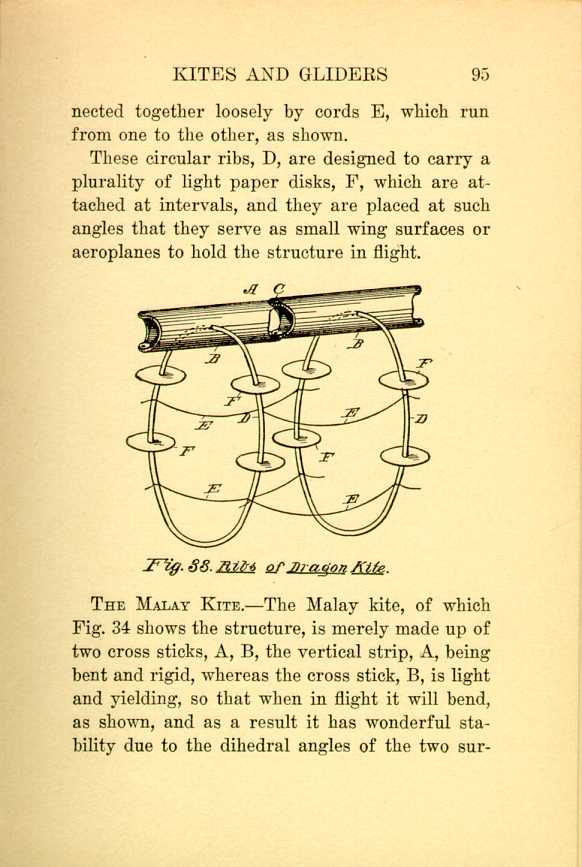
Fig. 33. Ribs of Dragon Kite
[Description: Black and white illustration: a technical diagram.]
THE MALAY KITE.—The Malay kite, of which Fig. 34 shows the structure, is merely made up of two cross sticks, A, B, the vertical strip, A, being bent and rigid, whereas the cross stick, B, is light and yielding, so that when in flight it will bend, as shown, and as a result it has wonderful stability due to the dihedral angles of the two surfaces.
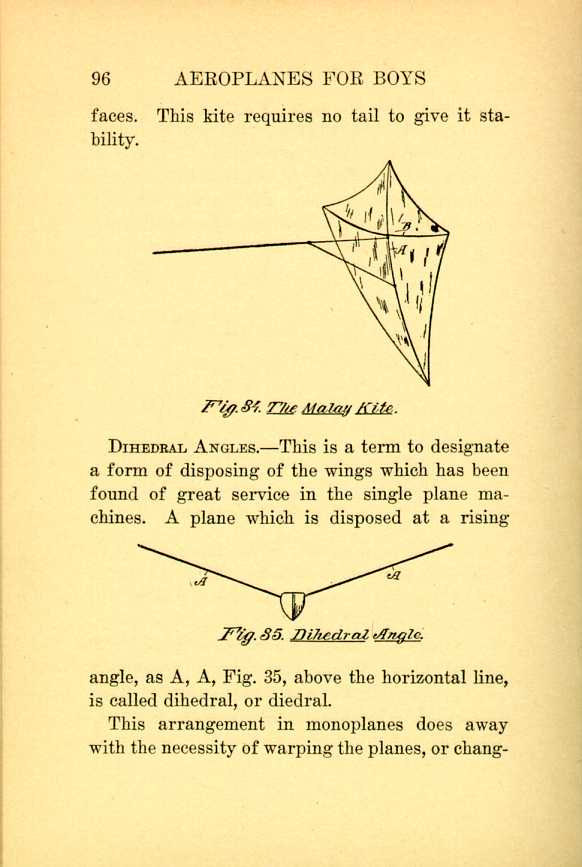
Fig. 34. The Malay Kite.
[Description: Black and white illustration: a technical diagram.]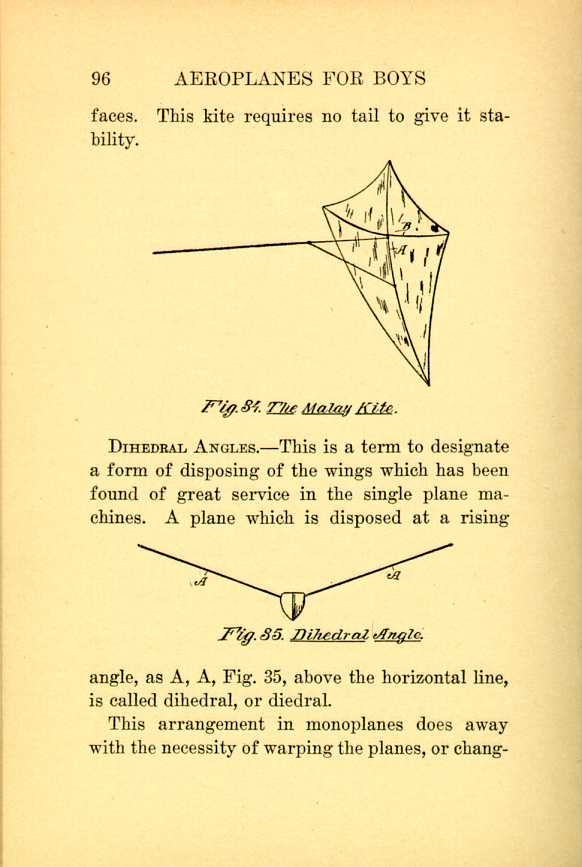
Fig. 35. Dihedral Angle.
[Description: Black and white illustration: a technical diagram.]This arrangement in monoplanes does away with the necessity of warping the planes, or changing
THE COMMON KITE.—While the Malay kite has
only two points of cord attachment, both along
the vertical rib, the common kite, as shown in
Fig. 36, has a four-point connection, to which the
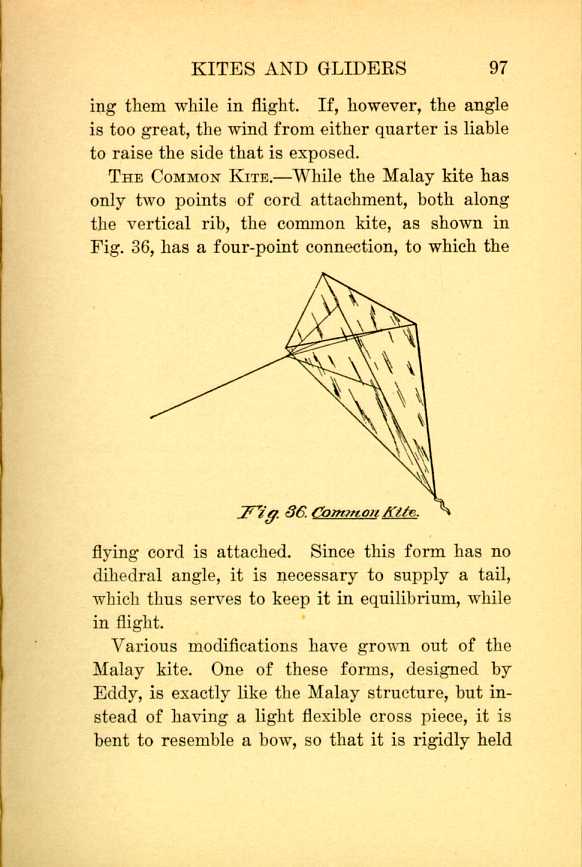
Fig. 36. Common Kite.
[Description: Black and white illustration: a technical diagram.]
Various modifications have grown out of the Malay kite. One of these forms, designed by Eddy, is exactly like the Malay structure, but instead of having a light flexible cross piece, it is bent to resemble a bow, so that it is rigidly held
THE BOW KITE.—Among the different types are
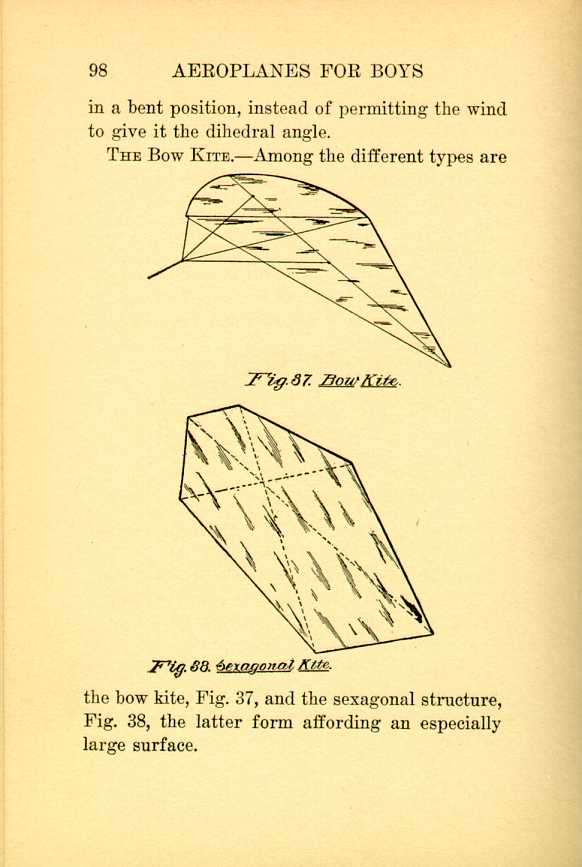
Fig. 37. Bow Kite.
[Description: Black and white illustration: a technical diagram.]
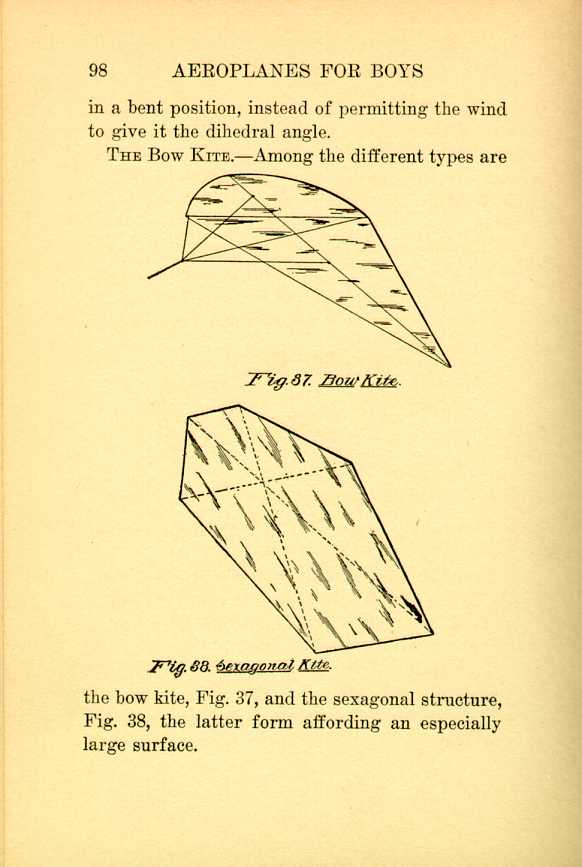
Fig. 38. Sexagonal Kite.
[Description: Black and white illustration: a technical diagram.]
THE BOX KITE.—The most marked improvement in the form of kites was made by Hargreaves, in 1885, and called the box kite. It has wonderful stability, and its use, with certain modifications, in Weather Bureau experiments, have proven its value.
It is made in the form of two boxes, A, B, open
at the ends, which are secured together by means
of longitudinal bars, C, that extends from one to
the other, so that they are held apart a distance,
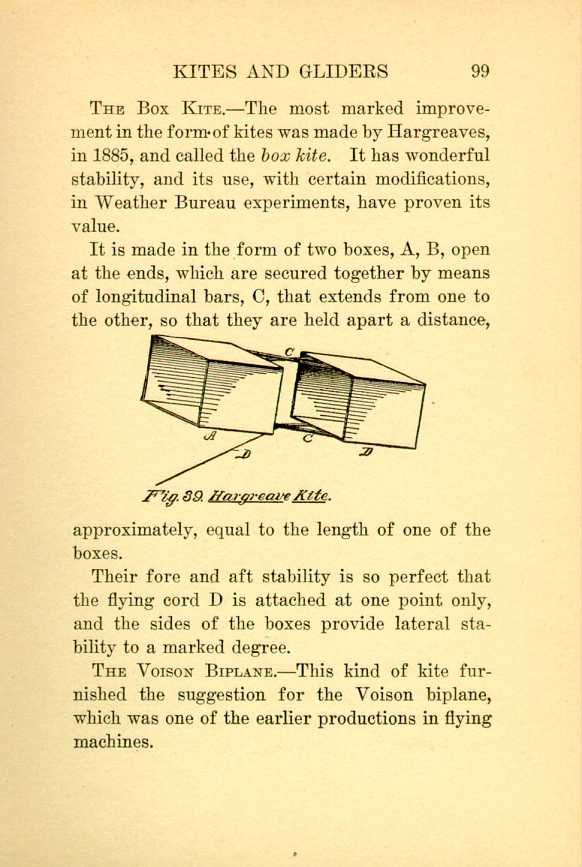
Fig. 39. Hargreave Kite.
[Description: Black and white illustration: a technical diagram.]
Their fore and aft stability is so perfect that the flying cord D is attached at one point only, and the sides of the boxes provide lateral stability to a marked degree.
THE VOISON BIPLANE.—This kind of kite furnished the suggestion for the Voison biplane, which was one of the earlier productions in flying machines.
Fig. 40 shows a perspective of the Voison plane, which has vertical planes A, A, at the ends, and also intermediate curtains B, B. This was found to be remarkably stable, but during its turning movements, or in high winds, was not satisfactory, and for that reason was finally abandoned.
LATERAL STABILITY IN KITES NOT CONCLUSIVE AS
TO PLANES.—This is instanced to show that while
such a form is admirably adapted for kite purposes,
where vertical curtains are always in line
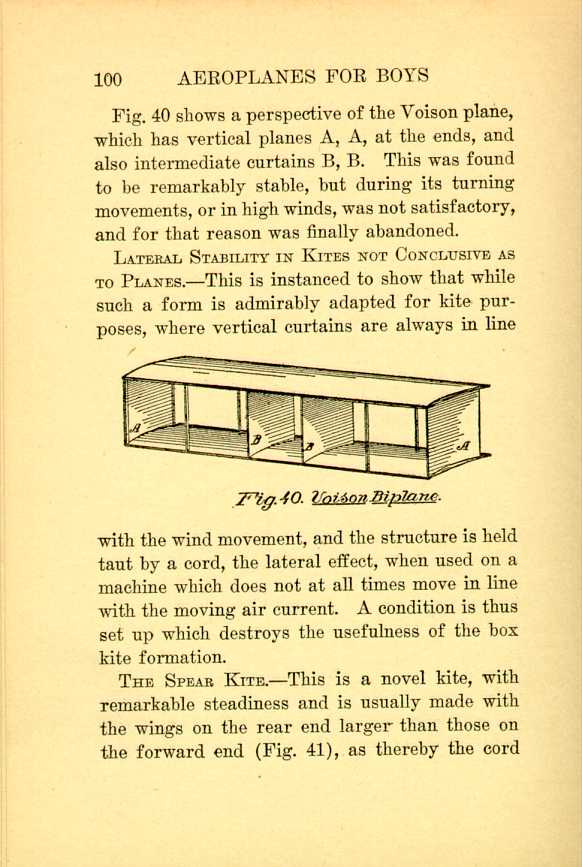
Fig. 40. Voison Biplane.
[Description: Black and white illustration: a technical diagram.]
THE SPEAR KITE.—This is a novel kite, with remarkable steadiness and is usually made with the wings on the rear end larger than those on the forward end (Fig. 41), as thereby the cord
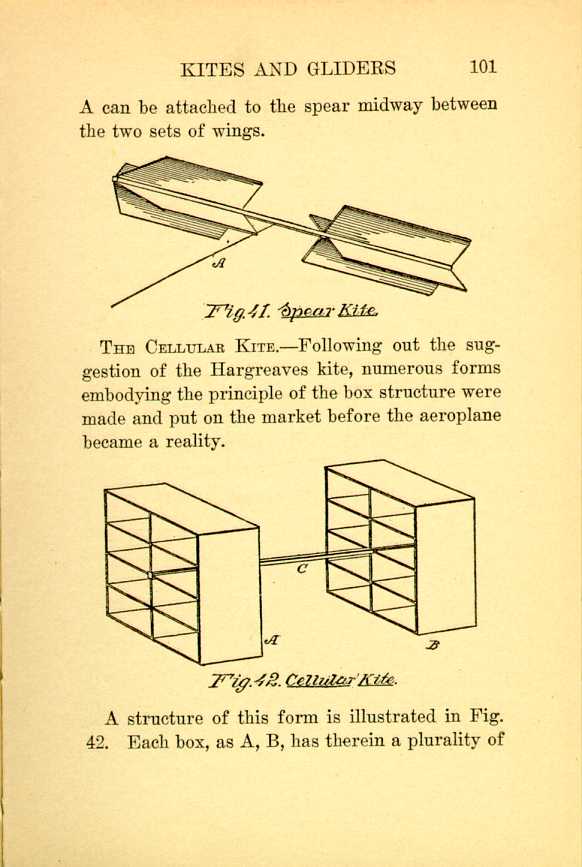
Fig. 41. Spear Kite.
[Description: Black and white illustration: a technical diagram.]THE CELLULAR KITE.—Following out the suggestion
of the Hargreaves kite, numerous forms
embodying the principle of the box structure were
made and put on the market before the aeroplane
became a reality.
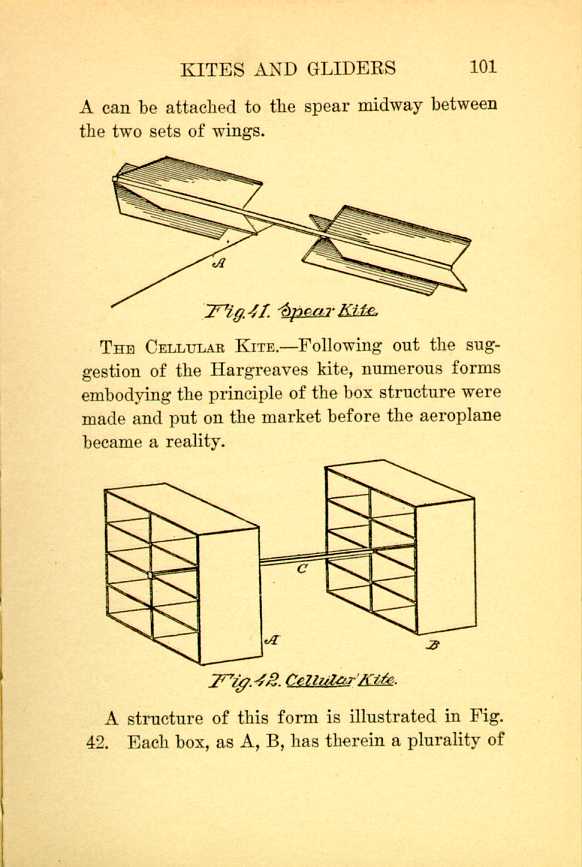
Fig. 42. Cellular Kite.
[Description: Black and white illustration: a technical diagram.]
A structure of this form is illustrated in Fig. 42. Each box, as A, B, has therein a plurality of
This type is remarkably stable, due to the small cells, and kites of this kind are largely used for making scientific experiments.
THE TETRAHEDRAL KITE.—Prof. Bell, inventor
of the telephone, gave a great deal of study to
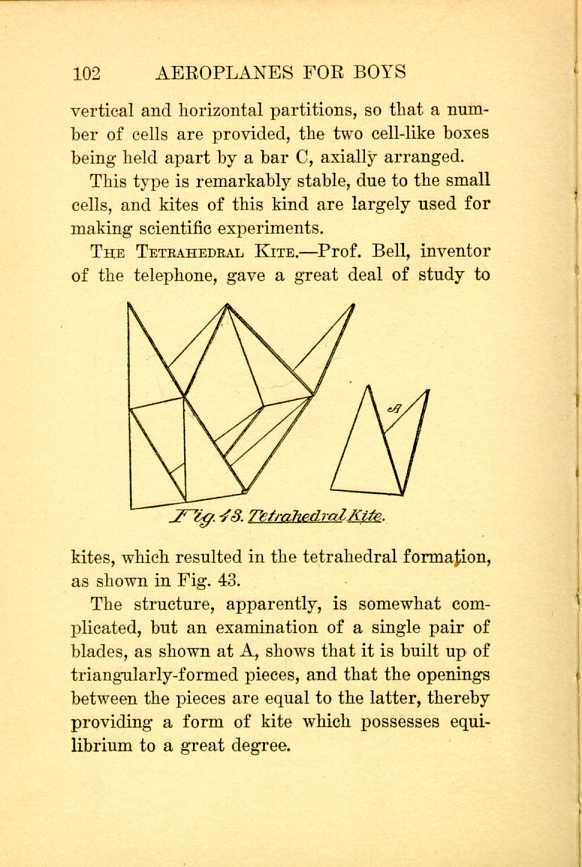
Fig. 43. Tetrahedral Kite.
[Description: Black and white illustration: a technical diagram.]
The structure, apparently, is somewhat complicated, but an examination of a single pair of blades, as shown at A, shows that it is built up of triangularly-formed pieces, and that the openings between the pieces are equal to the latter, thereby providing a form of kite which possesses equilibrium to a great degree.
It has never been tried with power, and it is doubtful whether it would be successful as a sustaining surface for flying machines, for the same reasons that caused failure with the box-like formation of the Voison Machine.
THE DELTOID.—The deltoid is the simplest, and
the most easily constructed of all the kites. It is
usually made from stiff cardboard, A-shaped in
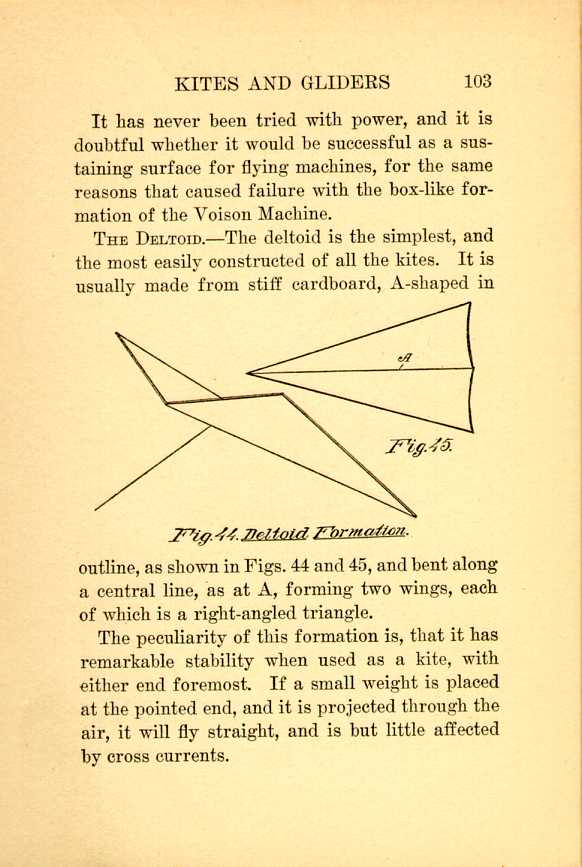
Fig. 44. [and 45.] Deltoid Formation.
[Description: Black and white illustration: a technical diagram.]
The peculiarity of this formation is, that it has remarkable stability when used as a kite, with either end foremost. If a small weight is placed at the pointed end, and it is projected through the air, it will fly straight, and is but little affected by cross currents.
THE DUNNE FLYING MACHINE.—A top view of
this biplane is shown in Fig. 46. The A-shaped
disposition of the planes, gives it good lateral
stability, but it has the disadvantage under which
all aeroplanes labor, that the entire body of the
machine must move on a fore and aft vertical
plan in order to ascend or descend.
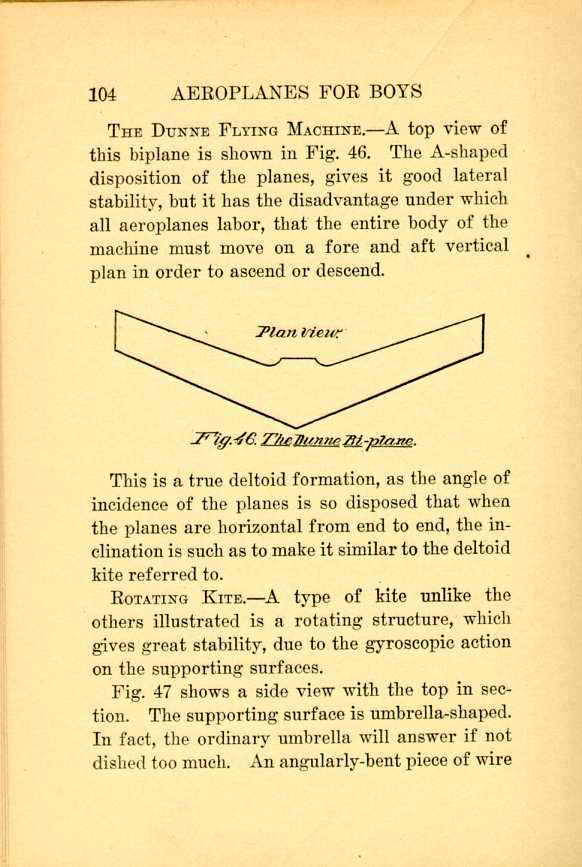
Fig. 46. The Dunne Bi-plane.
[Description: Black and white illustration: a technical diagram.]
This is a true deltoid formation, as the angle of incidence of the planes is so disposed that when the planes are horizontal from end to end, the inclination is such as to make it similar to the deltoid kite referred to.
ROTATING KITE.—A type of kite unlike the others illustrated is a rotating structure, which gives great stability, due to the gyroscopic action on the supporting surfaces.
Fig. 47 shows a side view with the top in section. The supporting surface is umbrella-shaped. In fact, the ordinary umbrella will answer if not dished too much. An angularly-bent piece of wire
At the bend of the wire loop C, the cord D is
attached. The lower side of the umbrella top has
cup-shaped pockets E, near the margin, so arranged
that their open ends project in the same
direction, and the wind catching them rotates the
circular plane.
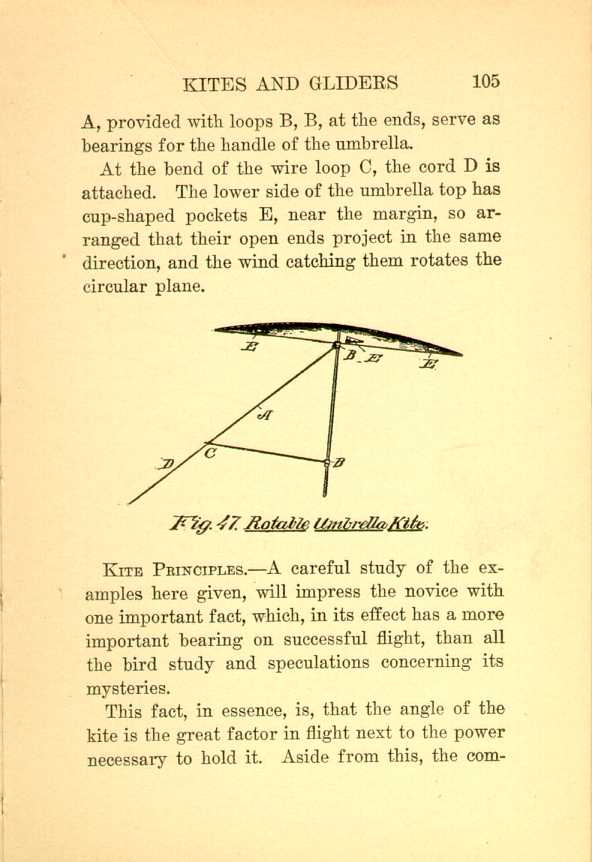
Fig. 47. Rotable Umbrella Kite.
[Description: Black and white illustration: a technical diagram.]
KITE PRINCIPLES.—A careful study of the examples here given, will impress the novice with one important fact, which, in its effect has a more important bearing on successful flight, than all the bird study and speculations concerning its mysteries.
This fact, in essence, is, that the angle of the kite is the great factor in flight next to the power necessary to hold it. Aside from this, the comparison
Disregarding the element of momentum, the drift of a machine against a wind, is the same, dynamically, as a plane at rest with the wind moving past it. But there is this pronounced difference: The cord which supports the kite holds it so that the power is in one direction only.
When a side gust of wind strikes the kite it is moved laterally, in sympathy with the kite, hence the problem of lateral displacement is not the same as with the aeroplane.
LATERAL STABILITY IN KITES.—In the latter the power is definitely fixed with relation to the machine itself, and if we should assume that a plane with a power on it sufficient to maintain a flight of 40 miles an hour, should meet a wind moving at the same speed, the machine would be stationary in space.
Such a condition would be the same, so far as the angles of the planes are concerned, with a kite held by a string, but there all similarity in action ends.
The stabilizing quality of the kite may be perfect, as the wind varies from side to side, but the aeroplane, being free, moves to the right or to the left, and does not adjust itself by means of a fixed point, but by a movable one.
SIMILARITY OF FORE AND AFT CONTROL.—Fore and aft, however, the kite and aeroplane act the same. Fig. 48 shows a diagram which illustrates the forces which act on the kite, and by means of which it adjusts its angle automatically.
Let us assume that the kite A is flown from
a cord B, so that its angle is 22½ degrees, the
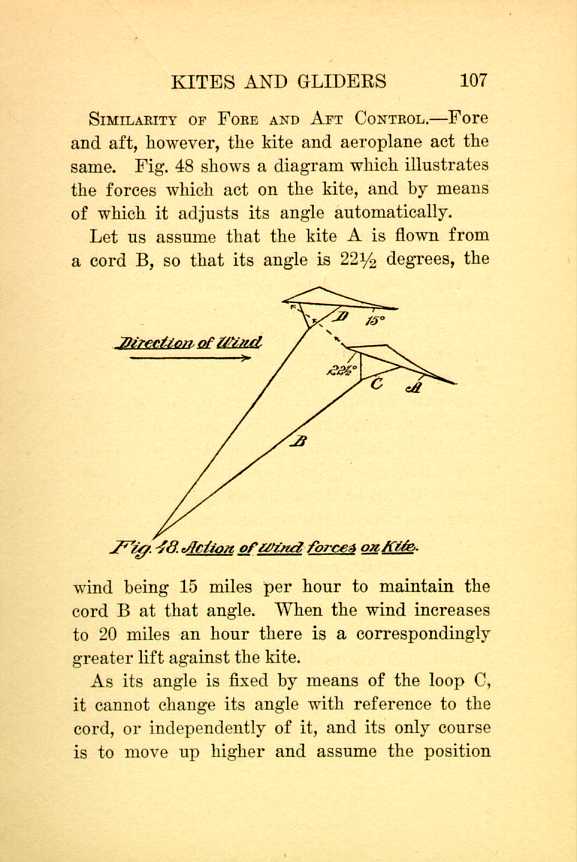
Fig. 48. Action of Wind forces on Kite.
[Description: Black and white illustration: a technical diagram.]
As its angle is fixed by means of the loop C, it cannot change its angle with reference to the cord, or independently of it, and its only course is to move up higher and assume the position
In the case of the aeroplane the effect is similar from the standpoint of power and disposition of the planes. If it has sufficient power, and the angle of the planes is not changed, it will ascend; if the planes are changed to 15 degrees to correspond with the kite angle it will remain stationary.
GLIDING FLIGHT.—The earliest attempt to fly by gliding is attributed to Oliver, a Monk of Malmesbury who, in 1065 prepared artificial wings, and with them jumped from a tower, being injured in the experiment.
Nearly 700 years later, in 1801, Resnier, a Frenchman, conducted experiments with varying results, followed by Berblinger, in 1842, and LeBris, a French sailor, in 1856.
In 1884, J. J. Montgomery, of California, designed a successful glider, and in 1889 Otto and Gustav Lilienthal made the most extended tests, in Germany, and became experts in handling gliders.
Pilcher, in England, was the next to take up the subject, and in 1893 made many successful glides, all of the foregoing machines being single plane surfaces, similar to the monoplane.
Long prior to 1896 Octave Chanute, an engineer,
He was an ardent believer in the ability of man to fly by soaring means, and without using power for the purpose.
It is doubtful whether gliders contributed much to the art in the direction of laterally stabilizing aeroplanes. They taught useful lessons with respect to area and fore and aft control.
The kite gave the first impulse to seek out a means for giving equilibrium to planes, and Montgomery made a kite with warping wings as early as 1884.
Penaud, a Frenchman, in 1872, made a model aeroplane which had the stabilizing means in the tail. All these grew out of kite experiments; and all gliders followed the kite construction, or the principles involved in them, so that, really, there is but one intervening step between the kite and the flying machine, as we know it, the latter being merely kites with power attached, as substitutes for the cords.
ONE OF THE USES OF GLIDER EXPERIMENTS.—There is one direction in which gliders are valuable to the boy and to the novice who are interested in aviation. He may spend a lifetime in gliding and not advance in the art. It is questionable
When in a glider quick thinking is necessary. The ability to shift from one position to another; to apply the weight where required instantaneously; to be able during the brief exciting moment of flight to know just what to do, requires alertness.
Some are so wedded to the earth that slight elevation disturbs them. The sensation in a glider while in flight is unlike any other experience. It is like riding a lot of tense springs, and the exhilaration in gliding down the side of a hill, with the feet free and body suspended, is quite different from riding in an aeroplane with power attached.
HINTS IN GLIDING.—It seems to be a difficult matter to give any advice in the art of gliding. It is a feat which seems to necessitate experiment from first to last. During the hundreds of tests personally made, and after witnessing thousands of attempts, there seems to be only a few suggestions or possible directions in which caution might be offered.
First, in respect to the position of the body at
Now the center of air pressure in gliding may not be at the same point as its sustaining weight when held by the hand, and furthermore, as the arm-pits, by which the body of the experimenter are held while gliding, are not at the same point, but to the rear of the hands, the moment the glider is launched too great a weight is brought to the rear margin of the planes, hence its forward end lifts up.
This condition will soon manifest itself, and be corrected by the experimenter; but there is another difficulty which is not so easy to discover and so quick to remedy, and that is the swing of the legs the moment the operator leaves the ground.
The experimenter learns, after many attempts, that gliding is a matter of a few feet only, and he anticipates landing too soon, and the moment he leaps from the ground the legs are swung forwardly ready to alight.
This is done unconsciously, just as a jumper swings his legs forwardly in the act of alighting. Such a motion naturally disturbs the fore and aft stability of the gliding machine, by tilting up the
The constant fear of all gliders is, that the machine will point downwardly, and his motion, as well as the position of the body, tend to shoot it upwardly, instead.
| CHAPTER VIII
KITES AND GLIDERS Aeroplanes | ||